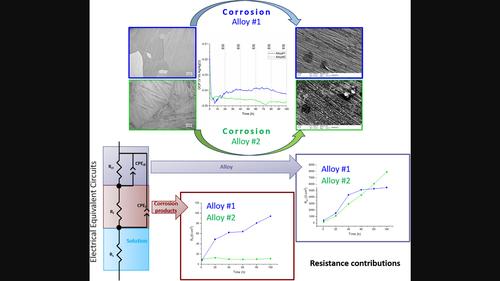当前位置:
X-MOL 学术
›
Mater. Corros.
›
论文详情
Our official English website, www.x-mol.net, welcomes your feedback! (Note: you will need to create a separate account there.)
Corrosion behavior of two Cu‐based shape memory alloys in NaCl solution: An electrochemical study
Materials and Corrosion ( IF 1.8 ) Pub Date : 2024-04-15 , DOI: 10.1002/maco.202314227 Roberto Spotorno 1 , Elisa Fracchia 2, 3 , Christian Krancher 4 , Romina Krieg 4 , Ralf Theiß 4 , Peter Dültgen 4 , Francesco Marco Pezzana 1 , Federico Simone Gobber 3 , Marco Actis Grande 3 , Paolo Piccardo 1
Materials and Corrosion ( IF 1.8 ) Pub Date : 2024-04-15 , DOI: 10.1002/maco.202314227 Roberto Spotorno 1 , Elisa Fracchia 2, 3 , Christian Krancher 4 , Romina Krieg 4 , Ralf Theiß 4 , Peter Dültgen 4 , Francesco Marco Pezzana 1 , Federico Simone Gobber 3 , Marco Actis Grande 3 , Paolo Piccardo 1
Affiliation

|
The corrosion behavior of two different Cu–Al–Mn–Ni alloys, pseudoelastic and pseudoplastic, was studied in a 0.6 M sodium chloride aqueous solution by monitoring the open circuit potential for 100 h and characterizing the resulting corrosion products. Electrochemical impedance spectroscopy analysis detected three processes related to the electrochemical double layer, a passive film and a diffusive contribution associated with the dissolution/precipitation of corrosion products. Potentiodynamic scans revealed a cathodically controlled corrosion mechanism and the presence of active–passive behavior at anodic potentials for both alloys studied. Polarization of the samples at selected potentials in the anodic branch allowed the investigation of the reactions involved, highlighting an improved corrosion resistance of the pseudoelastic alloy. The corrosion rates of the pseudoelastic and pseudoplastic alloys, after 100 h of immersion, were determined to be 0.007 and 0.011 mmpy, respectively. The post‐experiment characterization was carried out by means of scanning electron microscopy, micro‐Raman spectroscopy and X‐ray diffraction, supporting the electrochemical results.
中文翻译:

两种铜基形状记忆合金在氯化钠溶液中的腐蚀行为:电化学研究
通过监测 100 小时的开路电位并表征所得腐蚀产物,研究了两种不同 Cu-Al-Mn-Ni 合金(假弹性和假塑性)在 0.6 M 氯化钠水溶液中的腐蚀行为。电化学阻抗谱分析检测到与电化学双层、钝化膜以及与腐蚀产物的溶解/沉淀相关的扩散贡献相关的三个过程。动电位扫描揭示了所研究的两种合金的阴极控制腐蚀机制以及在阳极电位下存在主动-被动行为。阳极分支中选定电位下的样品极化可以研究所涉及的反应,突出显示伪弹性合金的耐腐蚀性能得到改善。浸泡 100 小时后,假弹性和假塑性合金的腐蚀速率分别为 0.007 和 0.011 mmpy。通过扫描电子显微镜、显微拉曼光谱和X射线衍射进行了实验后表征,支持了电化学结果。
更新日期:2024-04-15
中文翻译:

两种铜基形状记忆合金在氯化钠溶液中的腐蚀行为:电化学研究
通过监测 100 小时的开路电位并表征所得腐蚀产物,研究了两种不同 Cu-Al-Mn-Ni 合金(假弹性和假塑性)在 0.6 M 氯化钠水溶液中的腐蚀行为。电化学阻抗谱分析检测到与电化学双层、钝化膜以及与腐蚀产物的溶解/沉淀相关的扩散贡献相关的三个过程。动电位扫描揭示了所研究的两种合金的阴极控制腐蚀机制以及在阳极电位下存在主动-被动行为。阳极分支中选定电位下的样品极化可以研究所涉及的反应,突出显示伪弹性合金的耐腐蚀性能得到改善。浸泡 100 小时后,假弹性和假塑性合金的腐蚀速率分别为 0.007 和 0.011 mmpy。通过扫描电子显微镜、显微拉曼光谱和X射线衍射进行了实验后表征,支持了电化学结果。



























 京公网安备 11010802027423号
京公网安备 11010802027423号